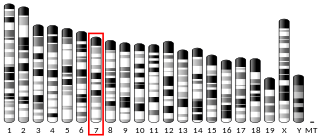Kallmann syndrome (KS) is a genetic disorder that prevents a person from starting or fully completing puberty. Kallmann syndrome is a form of a group of conditions termed hypogonadotropic hypogonadism. To distinguish it from other forms of hypogonadotropic hypogonadism, Kallmann syndrome has the additional symptom of a total lack of sense of smell (anosmia) or a reduced sense of smell. If left untreated, people will have poorly defined secondary sexual characteristics, show signs of hypogonadism, almost invariably are infertile and are at increased risk of developing osteoporosis. A range of other physical symptoms affecting the face, hands and skeletal system can also occur.

Neurotrophin-4 (NT-4), also known as neurotrophin-5 (NT-5), is a protein that in humans is encoded by the NTF4 gene. It is a neurotrophic factor that signals predominantly through the TrkB receptor tyrosine kinase.

Fibroblast growth factor receptor 2 (FGFR2) also known as CD332 is a protein that in humans is encoded by the FGFR2 gene residing on chromosome 10. FGFR2 is a receptor for fibroblast growth factor.

DAX1 is a nuclear receptor protein that in humans is encoded by the NR0B1 gene. The NR0B1 gene is located on the short (p) arm of the X chromosome between bands Xp21.3 and Xp21.2, from base pair 30,082,120 to base pair 30,087,136.

Gamma-aminobutyric acid receptor subunit beta-3 is a protein that in humans is encoded by the GABRB3 gene. It is located within the 15q12 region in the human genome and spans 250kb. This gene includes 10 exons within its coding region. Due to alternative splicing, the gene codes for many protein isoforms, all being subunits in the GABAA receptor, a ligand-gated ion channel. The beta-3 subunit is expressed at different levels within the cerebral cortex, hippocampus, cerebellum, thalamus, olivary body and piriform cortex of the brain at different points of development and maturity. GABRB3 deficiencies are implicated in many human neurodevelopmental disorders and syndromes such as Angelman syndrome, Prader-Willi syndrome, nonsyndromic orofacial clefts, epilepsy and autism. The effects of methaqualone and etomidate are mediated through GABBR3 positive allosteric modulation.

Transcription factor MafB also known as V-maf musculoaponeurotic fibrosarcoma oncogene homolog B is a protein that in humans is encoded by the MAFB gene. This gene maps to chromosome 20q11.2-q13.1, consists of a single exon and spans around 3 kb.

Forkhead box protein E1 is a protein that in humans is encoded by the FOXE1 gene.

Transcription factor AP-2 alpha, also known as TFAP2A, is a protein that in humans is encoded by the TFAP2A gene.

GDNF family receptor alpha-3 (GFRα3), also known as the artemin receptor, is a protein that in humans is encoded by the GFRA3 gene.

GDNF family receptor alpha-2 (GFRα2), also known as the neurturin receptor, is a protein that in humans is encoded by the GFRA2 gene.

PHD finger protein 8 is a protein that in humans is encoded by the PHF8 gene.

Nasal embryonic luteinizing hormone-releasing hormone factor is a protein that in humans is encoded by the NELF gene.

Pituitary homeobox 3 is a protein that in humans is encoded by the PITX3 gene.

Cleft lip and palate transmembrane protein 1 (Clptm1) is a multi-transmembrane protein that in humans is encoded by the CLPTM1 gene. Clptm1 was characterized in 1995 as a surface membrane protein in the thymus during embryonic development in mice and is suggested to have an important role in T-cell development. A more recent study shows a role in GABAA receptor subunit intracellular anchoring and regulation resulting in an influence on synaptic strength Clptm1 belongs to a family of several eukaryotic cleft lip and palate transmembrane protein 1 sequences.

T-box transcription factor TBX22 is a protein that in humans is encoded by the TBX22 gene.

Cysteine-rich motor neuron 1 protein is a protein that in humans is encoded by the CRIM1 gene.

Special AT-rich sequence-binding protein 2 (SATB2) also known as DNA-binding protein SATB2 is a protein that in humans is encoded by the SATB2 gene. SATB2 is a DNA-binding protein that specifically binds nuclear matrix attachment regions and is involved in transcriptional regulation and chromatin remodeling. SATB2 shows a restricted mode of expression and is expressed in certain cell nuclei. The SATB2 protein is mainly expressed in the epithelial cells of the colon and rectum, followed by the nuclei of neurons in the brain.

Teashirt zinc finger homeobox 1 is a protein that in humans is encoded by the TSHZ1 gene.

UPF0739 protein C1orf74 is a protein that in humans is encoded by the C1orf74 gene.

ABR, RhoGEF and GTPase activating protein is a protein that in humans is encoded by the ABR gene.






















